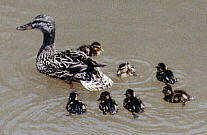The City Naturalist
Mallard Duck
 Article
and Photos by Leslie Day
Article
and Photos by Leslie Day
MALLARD DUCK (Anas Platyrhynchos from Latin Anas (duck) and from Greek Platys (broad or flat) and rynchos (beak).) "Mallard" relates to maleness from Old French "Wild drake" from masle: male.
OTHER NAMES: Common Mallard; common wild duck; curly-tail; domestic duck; English duck; French duck; gray duck; gray mallard; greenhead and stock duck.
DESCRIPTION: Mallards are known as "surface feeding" ducks because they dip and dabble in the shallows of fresh and salt water marshes. They do not usually dive below the surface, except that young birds or molting (flightless) adults sometimes dive to avoid danger. Mallards are agile fliers who can take off almost vertically. The Mallard is a wide ranging duck and it is the most abundant duck in the Mississippi Valley. Its numbers are increasing in the East.
WHERE TO LOOK:
Riverside Park: 79th Street Boat Basin
Central Park: The Harlem Meer (110th Street and Lenox Avenue) or
The Lake (West 72nd Street)
 DESCRIPTION:
The male can be recognized by its distinctive glossy green head,
white neck band and rusty colored breast. The female is a mottled
brown. Both sexes share a blue speculum (a bright blue rectangle
of color) and a white bar on both sides at the hind end of the
wing where it joins the body. The male has very curly tail
feathers and bright orange feet. Mallards can range in size from
20-28 inches long with a wingspan reaching between 30 and 40
inches. The male is larger than the female. This is most
noticeable when they are out of the water.
DESCRIPTION:
The male can be recognized by its distinctive glossy green head,
white neck band and rusty colored breast. The female is a mottled
brown. Both sexes share a blue speculum (a bright blue rectangle
of color) and a white bar on both sides at the hind end of the
wing where it joins the body. The male has very curly tail
feathers and bright orange feet. Mallards can range in size from
20-28 inches long with a wingspan reaching between 30 and 40
inches. The male is larger than the female. This is most
noticeable when they are out of the water.
RANGE: The mallard is the best known and
possibly most abundant wild duck in the Northern Hemisphere. Its
North American population is nearly 9 million. In summer the
mallard can be seen throughout Alaska and much of Canada and
northern United States. Nesting takes place primarily in the
prairie provinces of Canada. The Mallard winters as far north as
there is open water. It generally avoids salt water and prefers
any shallow body of fresh water. Occasionally they are seen in
shallow protected marine waters such as the 79th Street Boat
Basin on the Hudson River. Large numbers of mallards congregate
at the Marina during the winter because of winter feeding by Boat
Basin residents and park visitors.
 NESTING AND BREEDING: In March
and April the Mallard begins its migration northward towards its
breeding grounds, which are typically in the numerous lakes of
the prairie provinces of Canada or northern United States. It may
nest as early as February along the Pacific Coast where it is
warmer. The nest is usually built on the ground among dead
grasses, reeds, edges of lakes, reservoirs, on muskrat houses, in
marshes or marshy ground and sometimes far form the water on
higher ground. They also nest among dense stands of phragmites
reeds, on islands or bulrushes of swampy creeks, or even in the
hollow of a tree.
NESTING AND BREEDING: In March
and April the Mallard begins its migration northward towards its
breeding grounds, which are typically in the numerous lakes of
the prairie provinces of Canada or northern United States. It may
nest as early as February along the Pacific Coast where it is
warmer. The nest is usually built on the ground among dead
grasses, reeds, edges of lakes, reservoirs, on muskrat houses, in
marshes or marshy ground and sometimes far form the water on
higher ground. They also nest among dense stands of phragmites
reeds, on islands or bulrushes of swampy creeks, or even in the
hollow of a tree.
 EGGS:
The female produces between 8 and 10 light green eggs which she
incubates for 30 days. The ducklings are lead to water as soon as
their soft, downy feathers are dry and they first fly about 2
months after hatching. The residents of the 79th Street Boat
Basin and Riverside Park Visitors are fortunate to witness a
series of new hatchlings each year from May into July.
EGGS:
The female produces between 8 and 10 light green eggs which she
incubates for 30 days. The ducklings are lead to water as soon as
their soft, downy feathers are dry and they first fly about 2
months after hatching. The residents of the 79th Street Boat
Basin and Riverside Park Visitors are fortunate to witness a
series of new hatchlings each year from May into July.
FEEDING HABITS: The mallard feeds by "tipping up" and reaching below the surface with its bill in the shallows of ponds, lakes, streams and swamps. Mallards can feed anywhere that water is a foot or two deep, although they can reach for food in deeper water if necessary. Mallards are primarily vegetarians who eat various seeds including corn, wheat, barley, bulrushes, wild rice, primrose, willow, seeds of water elm, oak, hackberry and other trees of swamps or river bottoms. Mallards will also eat some mollusks, insects, small fish, tadpoles, freshwater snails and fish eggs.
About Leslie Day | For Further Information
Copyright © 1996-2012 The 79th Street Boat Basin Flora and Fauna Society.



